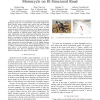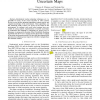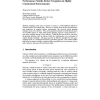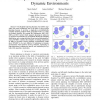114
click to vote
IROS
2006
IEEE
15 years 7 months ago
2006
IEEE
— We report our development of a vision-based motion planning system for an autonomous motorcycle designed for desert terrain, where uniform road surface and lane markings are no...
129
click to vote
ICRA
2006
IEEE
15 years 7 months ago
2006
IEEE
Abstract— Randomized motion planning techniques are responsible for many of the recent successes in robot control. However, most motion planning algorithms assume perfect and com...
105
click to vote
ICRA
2006
IEEE
15 years 7 months ago
2006
IEEE
Abstract— In this paper, we present an incremental, multiresolution motion planning algorithm designed for systems with differential constraints. Planning for these sytems is mor...
101
click to vote
ICRA
2006
IEEE
15 years 7 months ago
2006
IEEE
— The configuration space of a robot is partitioned into free space and C-obstacle space. Most of the prior work in collision detection and motion planning algorithms is targete...
107
Voted
FSR
2007
Springer
15 years 7 months ago
2007
Springer
Sampling in the space of controls or actions is a well-established method for ensuring feasible local motion plans. However, as mobile robots advance in performance and competence ...
95
Voted
IROS
2007
IEEE
15 years 7 months ago
2007
IEEE
— Motion planning for robotic arms is important for real, physical world applications. The planning for arms with high-degree-of-freedom (DOF) is hard because its search space is...
93
Voted
ICRA
2007
IEEE
15 years 7 months ago
2007
IEEE
— Distributed motion planning of multiple agents raises fundamental and novel problems in control theory and robotics. Recently, one such great challenge has been the development...
ICRA
2007
IEEE
15 years 7 months ago
2007
IEEE
— The success of sampling-based motion planners has resulted in a plethora of methods for improving planning components, such as sampling and connection strategies, local planner...
ICRA
2007
IEEE
15 years 7 months ago
2007
IEEE
Abstract— The Rapidly-exploring Random Tree (RRT) algorithm has found widespread use in the field of robot motion planning because it provides a single-shot, probabilistically c...
134
Voted
COLCOM
2007
IEEE
15 years 7 months ago
2007
IEEE
—In disaster areas, office buildings, or at home, multiple autonomous networked mobile robots may act instead of human beings. These robots have to move to their destination so ...




